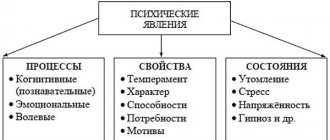The root cause, so to speak, of many things that happen in life is a person’s internal attitudes, which under certain conditions turn into a person’s beliefs. Especially when it comes to concepts of willpower or strength of character.
If in childhood and adolescence you most often have to rely on the experience of your parents, friends or just good acquaintances, then in more mature years you cannot do without your own life experience and views on the world around you.
So what are these human attitudes, how do they arise and develop, and how exactly do they influence our lives? Let's try to figure it out so that, thanks to awareness of this issue, we can significantly improve the quality of our life.
Psychological phenomenon
It is already obvious to a person living in the third millennium how rapidly the world in which he lives is changing. Moreover, any newly arriving reality is invariably accompanied by certain changes. This requires changes in the people themselves. But admitting that you need to change yourself is much more difficult. In each case, a mechanism to counteract the newly created conditions begins to work in a person, which is called a psychological barrier. This is nothing more than a specific form of resistance to change syndrome, which has two sides. A person is afraid of losing his old, familiar, and at the same time he has a fear of what is unusual for him, new.
If we consider the concept of “barrier” in a broad sense, then it means a long partition that is placed as an obstacle on the way, that is, it is an obstacle. This word has a similar meaning in the field of psychology. In this science, it denotes those external and internal obstacles existing in a person that do not allow him to achieve his goal.
A psychological barrier is understood as a state of an individual in which his or her inadequate passivity manifests itself, becoming an obstacle to performing certain actions. In emotional terms, the mechanism of this phenomenon is the strengthening of attitudes toward low self-esteem and negative experiences. Psychological barriers also exist in the social behavior of an individual. They are expressed by communication obstacles, which manifest themselves in the rigidity of interpersonal and other attitudes.
How to solve the problem of barriers? This will allow us to create a broader framework for such a concept as “psychological attitude.” It is expressed in a person’s readiness to act and perceive, as well as interpret the object of thinking and perception or future events in one way or another.
What does the concept of attitude mean in psychology? This is a special vision that is the basis of human behavior and his selective activity. It is capable of regulating conscious as well as unconscious forms of personality activity in the emotional, cognitive and motivational spheres. Any attitude is formed thanks to the life experience accumulated by a person and can be both a colossal advantage and a significant limitation for him.
Additional methods
The methods of psychological influence described above are used by people most often, but there are other, less popular methods of forming beliefs.
Favor
The goal is to increase a person’s loyalty to a certain belief. And for this, a person describes all the advantages and benefits of his installation. If another person is imbued with this, that is, becomes supportive, then he also adopts this belief.
Request
A calm pace of speech, a quiet tone, a smile, a couple of compliments, a small personal story - a set that increases the chances of success if you ask someone for something. A request can influence a person’s behavior, and based on this, he will form a new belief.
Self-promotion
This is a way to influence yourself. The point is that you demonstrate your best qualities, skills, knowledge. Due to this, your self-esteem increases and you achieve great success.
Compulsion
Like the two subsequent techniques, this is a cruel and destructive method of influence. Coercion involves changing a person's attitudes by playing on his survival instinct. Coercion involves the use of violence, blackmail, threats, and restriction of freedom.
Attack
Out of his own pain, a person attacks another, trying to convince him that he is bad. If we are talking about a moral attack, then this is shouting and insults. If we are talking about physical influence, then we are talking about the desire to convince a person of his physical weakness and worthlessness.
Manipulation
There are dozens of manipulative techniques, but they all have one goal - to force a person to do what is beneficial to the manipulator.
History of discovery
What is an attitude in psychology? This is an internal quality of the subject, a psychological state not realized by him, which is based on his previous life experience, as well as certain activity and predisposition in a given situation. The setting determines and precedes the deployment of any of the existing forms of mental activity. Moreover, its presence allows a person to react in one way or another to a social or political event.
A similar phenomenon was discovered in 1888 by the German scientist L. Lange. Further in general psychology, the attitude resulted in a whole theory developed by D. N. Uznadze together with the students and followers of his school. The stages necessary for the formation of an attitude were most fully revealed thanks to such a concept as the contrast illusion. At the same time, along with the simplest ones, researchers have identified more complex types of attitudes - social, value orientations of a person, etc.
Considerable attention was paid to the installations by S.R. Rubinstein. They discovered that this phenomenon is closely related to the unconscious.
M. Rokeach also worked on the problem of attitudes in psychology. This researcher made a distinction between a person's attitudes and his values. The latter are beliefs that sometimes apply to several situations and objects. An attitude is a set of beliefs that relate to only one situation or object.
How to end negative attitudes forever?
And the end of it all is like this. In three days, only after 3 days, you will be able to pick up an eraser. Before this, for three days, I recommend that you read your entire story in a row, morning and evening. Everything you wrote in pencil and red ink.
Reading sheets 16 and 18 takes 1 hour. About 1 hour you remember what you wrote. You will begin to feel something like a stirring in your head , this happens because you have formed new connections. They are still unstable, but the brain begins to form new neural connections and these connections begin to seem to move.
The first feeling is that this is normal, this is how it should be, this is right. The second feeling you will have is something like this:
“Well, why now do I read everything that was written in pencil? I don’t want to read it anymore, I only want to read what’s written in red ink.”
They must register with each other within three days. And it looks like this:
The subconscious mind only perceives what is written in red ink. But first you need to hook it so that the subconscious knows that this is not an affirmation, but that you want to replace the old file with a new one. And then, when you have already read all three days, it looks something like when you want to overwrite files on your computer.
The subconscious asks if we save this file, then the existing, old file will be deleted forever.
Replace? Replace.
So we replace all of that. From the moment you erase the entire pencil, you will only be left with red paste.
Erase the pencil and all your limitations will disappear.
A new picture of your life will remain and you begin to read it the same way, every day, morning and evening. This will take you 10 minutes in the morning and 10 minutes in the evening.
And just like that, for 6 months .
And everything that you write, not only will it give you fantastic pleasure, you will gradually begin to implement these new programs.
In the first week you will begin to see unusual events happening in your life.
If you have never been given a compliment, here you write in red ink:
“I am bathed in compliments” and you will receive them.
If you haven't received gratitude, you will start receiving gratitude. If you have not received gifts and surprises, things that have never happened to you will begin to happen to you.
And then you will simply begin to act only according to the new program for your happy life.
And if you are interested in learning about my experience in visualizing what you want, come to my free master class >>>
It turns out that this is how easy it is to remove all your negative attitudes! Who started writing, share in the comments what you believed in for many years?
Development of the theory
At the early stage of its study, it was believed that an attitude in psychology is one of the forms of nervous activity that is not conscious to a person. This opinion existed for quite a long time. The psychology of the attitude of D. N. Uznadze also adhered to it. This theory continued to develop in this direction. The attitude in domestic psychology was considered by the Georgian school, which included followers and students of Dmitry Nikolaevich Uznadze. This scientist not only created the theory of the phenomenon under consideration, but also organized the development of this problem.
Uznadze explained the phenomenon of perception as a reflection of reality and the behavior of a living being. This can be briefly explained as follows. Attitudes occupy the most important place in the life of every person. They influence the perception of phenomena and objects, thinking, as well as the will of a person. Before the slightest movement of the soul takes place, it will necessarily be preceded by a certain attitude. And then the act of will, perception and cognition will certainly be influenced by a person’s life experience, the goal or mood set by him. However, errors cannot be excluded. This was made possible by the experimental foundations of attitude psychology. This is evidenced, for example, by the experiment with balls. The person was asked to estimate the size of these objects. And if at first he was shown balls of different sizes 10-15 times, then in his mind there was an opinion that they must be different. After the researcher offered him the same objects, the reaction did not change. The person continued to perceive the balls as different.
Over time, it became obvious that all the patterns and facts that were considered by the attitude theory are general psychological in nature. In this regard, this direction began to claim the status of a general psychological concept.
Wisdom from the people
Historical events necessarily leave their mark on people's consciousness. For example, if you look at a woman who survived the war, she understands that she can only rely on herself.
Unconsciously, these attitudes are passed on to children, which affects their lives in modern society. Folk wisdom can also be attributed to this point. Various proverbs and sayings can become fundamental in life.
Clarification of the term
What is an attitude in psychology? This is a phenomenon that has a three-part structure, which includes:
- sensory image (effective component);
- actions related to the object of assessment (behavioral component);
- cognitive factor.
According to the opinion of D. N. Uznadze’s students - T. Sh. Iosebadze and T. T. Iosebadze, the following definition of attitude in psychology can be given. This phenomenon is characterized by scientists as a mode or a specific state inherent in a holistic object. That is, it determines the psychophysical organization of a person and its modification in each specific situation, as well as his readiness to perform certain activities necessary to satisfy current needs.
In psychology, an individual's attitude and behavior are considered to be a reflection of his internal (subjective) and external (objective) state. Moreover, such a property is considered an indirect link, a certain “principle of connection” that exists between the individual states of the subject, its elements and functions.
A clearer position on this issue belongs to Sh. N. Chkhartishvili. This scientist divided the installation into primary and fixed. Both of them are easily differentiated from each other, but have different functions and properties.
Notes
- VA Braithwaite, WA Scott. Values. // JP Robinson, PR Shaver, LS Wrightsman (eds.), Measures of Personality and Social Psychological Attitudes. New York: Academic Press, 1991.
- T. T. Iosebadze, T. Sh. Iosebadze. The problem of the unconscious and the theory of installation of the Uznadze school. In the book. Unconscious. Nature, functions, research methods. Under the general editorship of A. S. Prangishvili, A. E. Sherozia, F. V. Bassin. Tbilisi: Metsniereba Publishing House, 1985. Volume 4, p. 37.
- T. T. Iosebadze, T. Sh. Iosebadze. The problem of the unconscious and the theory of installation of the Uznadze school. In the book. Unconscious. Nature, functions, research methods. Under the general editorship of A. S. Prangishvili, A. E. Sherozia, F. V. Bassin. Tbilisi: Metsniereba Publishing House, 1985. Volume 4, pp. 45-46.
- A. S. Prangishvili, A. E. Sherozia, F. V. Bassin, Basic criteria for considering the unconscious as a unique form of mental activity. Introductory article by the editors. Unconscious: nature. functions, research methods, T.1. Tbilisi, Metsniereba, 1978, pp. 71-83.
- A. E. Sheroziya, On the problem of consciousness and the unconscious psyche. Experience of research based on data from the psychology of attitude, T.1. Tbilisi, 1969; A. E. Sheroziya, Psychoanalysis and the theory of unconscious psychological attitude: results and prospects. Unconscious: nature. functions, research methods, T.1., Tbilisi, Metsniereba, 1978, pp. 37-64.
- On the problem of consciousness and the unconscious psyche. Research experience based on data from attitude psychology. - T. 1. - Tbilisi, 1969
Dispositional concept
There are other attitude theories in psychology. One of them is the dispositional concept of V. A. Yadov. This scientist proposed his approach when considering system-forming components that reflect human social behavior.
The concept under consideration is based on a hierarchical system of dispositions. In the triad proposed by D. N. Uznadze, V. A. Yadov replaced the installation with the concept of disposition. This is nothing more than a wide variety of states of readiness or predisposition of a person to perceive situations. V. A. Yadov considers personality dispositions in the form of a hierarchical system formed as a result of existing needs and conditions. In this system, the scientist identified three levels. They differ from each other in their different composition and ratio of their constituent elements (attitudes, needs, operating conditions). Each level of disposition predetermines the corresponding level of behavior. Let's look at each of them in more detail.
Relevant products in the Online store:
Clinique
Clinique iD™ BB-Gel Moisturizing BB gel that corrects skin tone
from 2,190 rub.
Givenchy
Eau de Givenchy Rosee Eau de Toilette
from 5,145 rub.
Clinique
Clinique iD™ Dramatically Different™ Moisturizing Lotion+ Unique moisturizer (base - must be supplemented with concentrate)
from 2,190 rub.
Clinique
Clinique iD™ BB-Gel Moisturizing BB gel, correcting skin tone in travel format
from 1,755 rub.
All goods
Fixed installations
They are the ones who are at the very first and at the same time lower level of disposition. What is an elementary fixed installation? In psychology, this is the determination of the subject’s specific reactions to an objective, current situation, as well as his perception of rapidly changing environmental influences. Elementary attitudes are formed based on the basic needs of physical existence, as well as the simplest situations. This or that behavioral readiness of the individual in this case is fixed by his previous experience.
Social attitudes
A similar phenomenon is detected at the second stage of the dispositional stage. In psychology, a social attitude is a person’s need to be included in contact groups. What behavioral situations arise in this case? They are social. Such attitudes take place based on the assessment of individual public facilities. Social situations are also taken into account. At the same time, the individual commits certain actions. They are an elementary, socially significant unit of behavior.
What else do we understand by the term described? A social attitude in psychology is nothing more than an individual’s stable attitude towards people, as well as towards all processes and events occurring in society. It is from this that a personality characteristic can be given.
The term “social attitude” itself in psychology has several meanings, which differ from each other in their characteristics. Thus, initially this definition meant the readiness of an individual to solve a given problem. Moreover, what was the object of the social attitude? This is the person himself, as well as the people in his environment, events and processes in society, objects of spiritual and material culture, etc.
Somewhat later, the term in question began to have a slightly different meaning. A social attitude in psychology is a stable attitude of one person or group of people towards something or someone. A careful study of this phenomenon made it clear that it is quite complex. At the same time, such an attitude began to be classified not only as a mental state of the individual, but also as its psychological property.
Methods of influence
How to understand that you are guided by a psychological attitude:
- in your speech the words “must” and “must” prevail instead of “want”;
- you react emotionally to everything that happens (in a positive or negative way);
- you resort to generalizations (putting everyone under the same brush);
- you are carried away by value judgments and talk in stereotypes and sayings.
If you understand that the learned and habitual patterns of behavior are not leading you where you would like, then you need to change your beliefs. Remember that the quality and standard of your life, as well as your happiness and satisfaction with your life, depend on them. There are special methods or types of influence on oneself or another person in order to change attitudes.
General orientation of the individual
Let's consider the third level of disposition. It characterizes the general orientation of the individual into a certain sphere of social action. At this level, a person’s needs regarding his social connections become more complex. For example, an individual strives to join one or another area of activity, wanting to turn it into the main dominant sphere.
Here options such as professionalism, leisure or family may be considered. In this case, a person’s purposeful and consistent actions form the basis of his behavior in the area of activity where he pursues more distant and significant goals.
Levels
- the simplest form – regulates behavior in everyday life;
- social;
- basic social – the individual’s attitude to his areas of life (profession and work, interests, family);
- instrumental - acceptance and inclusion in the set of norms that have developed in society.
Attitude controls activity at 3 hierarchical stages:
- Semantic - is of a general nature and determines people’s position towards objects and events that are important to them.
- Target. Determines the relatively stable course of functioning and has a connection with the desire to bring the task to its logical conclusion.
- Operational. The perception of a specific phenomenon occurs through previous experience, as well as through forecasting the possibilities of productive actions and decision-making under certain circumstances.
Value orientations
Let's consider the highest level of the disposition hierarchy. It is characterized by the formation of value orientations not only on the goals of life, but also on the means necessary to achieve the goals. The fourth level includes higher social needs. In this case, an important factor becomes a person’s life position, into which the individual’s self-awareness is transformed. This is nothing more than the principle of individual behavior, which is based on ideological attitudes, norms and ideals, social values, as well as readiness to act.
Thanks to the dispositional theory, direct connections were established between socio-psychological and sociological human behavior. At the same time, the highest forms of attitudes according to Yadov include:
- value orientations and life concept;
- generalized attitudes towards typical social situations and objects;
- predisposition to behavior and perception in existing conditions and in a given social and subject environment.
Value orientations are understood as the attitude of a person or group of people to the totality of spiritual and material goods, considered as objects or their properties, goals, as well as means to satisfy the needs of the individual or group. This concept is expressed in the meaning of life, in ideals, and manifests itself in the social behavior of people. Value orientations reflect the subject’s attitude to the current conditions of his existence, which is the result of a conscious choice of objects and items that are significant for the individual.











